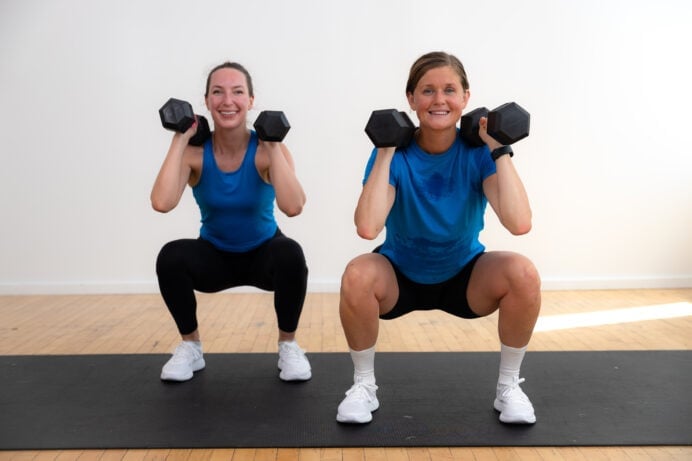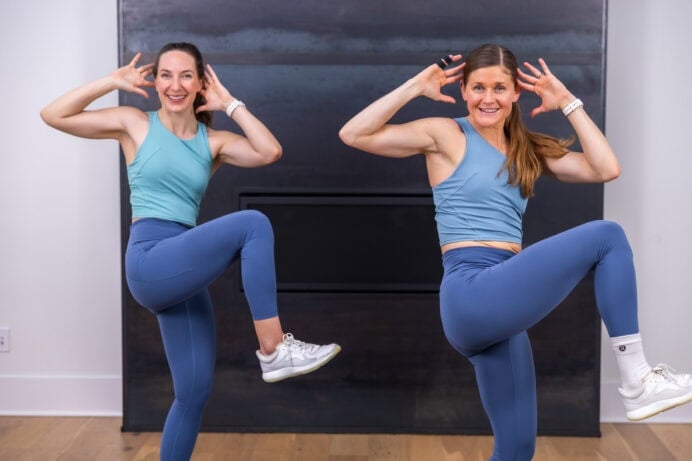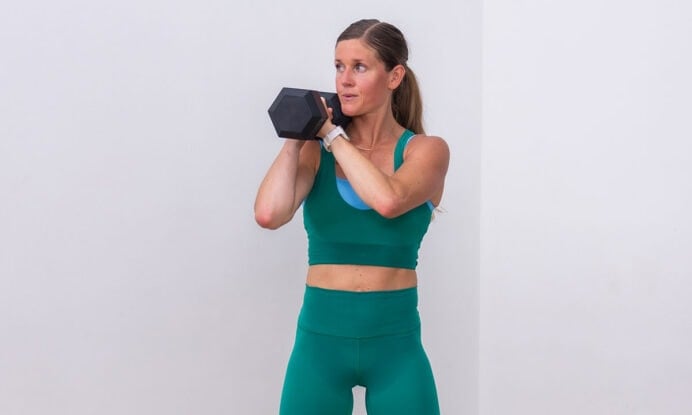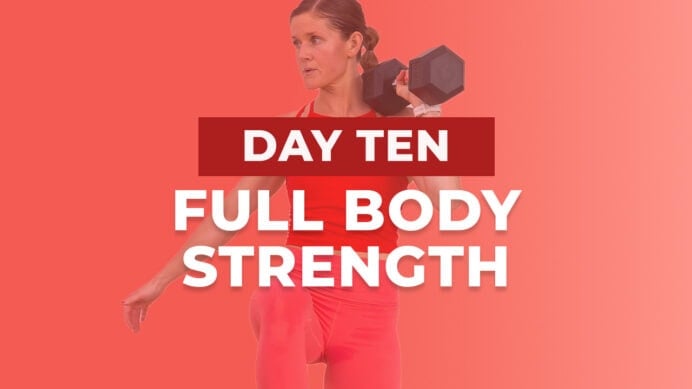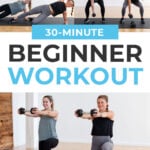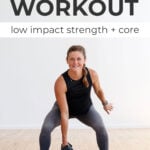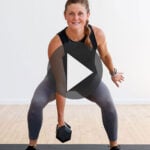
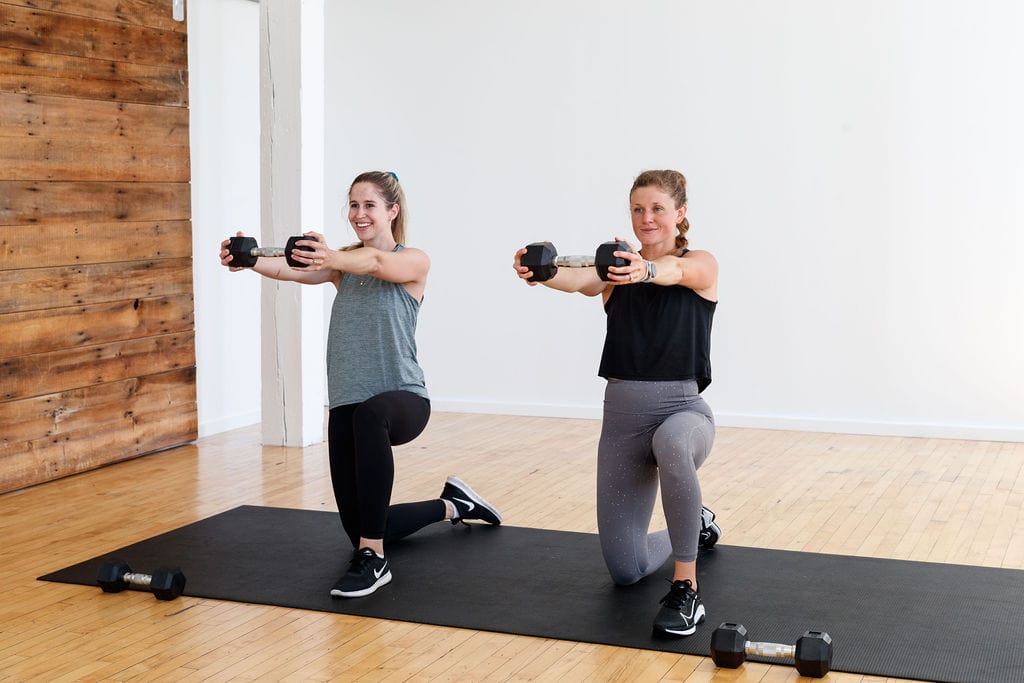
9 Postpartum Exercises For New Moms (30-Minute Full Body Workout)
Nine of the best postpartum exercises to build strength at home. Whether you’re a couple months or several years postpartum, this full body workout is a safe and low impact way to build strength at home in just 30 minutes.
As a fitness trainer and mom of three, I’m often asked: “What are the best exercises to do after having a baby?”
While it’s recommended you wait at least 12 weeks after birth before attempting running or high impact exercise, before the 12-week mark, you can work on core repair and low impact strength training.
Returning to exercise postpartum is so important for your physical and mental health. I personally found that rebuilding my physical strength helped me perform the daily activities of motherhood (like holding, wearing or carrying a baby for extended periods of time, transferring baby to a car seat, and pushing a stroller).
Postpartum exercise can also improve mood, energy levels, contribute to stress relief and prevent postpartum depression.
That said, I understand that with a new baby, there isn’t a lot of time to workout. In order to make the most of the time you do have, you’ll want to focus on compound exercises.
This full body strength workout combines 9 of my favorite compound strength exercises that are safe for postpartum.

9 Postpartum Exercises (30-Minute Postpartum Workout)
Build total body strength at home in just 30 minutes with these 9 postpartum exercises.
The best postpartum exercises include diastasis recti exercises, functional strength training exercises, and mobility exercises.
Add full body workouts like this one to your workout routine 1-2 times a week to build muscle mass and increase endurance.
Workout Equipment:
Medium Set of Dumbbells.
I recommend 5-15 lbs depending on your fitness level. I’m using 15 lb dumbbells and Katelyn is using 5-10 lb dumbbells.
Workout Instructions:
Follow along with the guided Full Body Postpartum Workout on YouTube, led by certified personal trainer, Lindsey Bomgren.
Your Workout Looks Like This:
- 3 Circuits (3 moves per circuit: upper body, lower body and core)
- Timed Intervals (40 seconds work per exercise, 20 seconds rest)
- Repeat Each Circuit x 2 Sets

Prefer to Watch On YouTube?
Workout Outline
CIRCUIT ONE:
- Stack On Back Rows and Bicep Curls
- 2-Pulse Squat and Loaded Squat Walk
- Half Kneeling Dumbbell Front Raise
CIRCUIT TWO:
- Launcher Plank Push Up
- Reverse Lunge and Lateral Lunge
- Dead Bug with Single Arm Chest Press
CIRCUIT THREE:
- Single Arm Tricep Kickback
- Staggered Deadlift and Staggered Squat
- Modified Side Plank Hip Lifts
BONUS ROUND:
- Glute Bridge and Glute Bridge Hold
9 Postpartum Exercises
Stack On Back Rows And Bicep Curls
Targets: Back muscles, biceps and core.

How To Do Stack On Dumbbell Back Rows And Bicep Curls
- Stand with your feet shoulder-width apart, knees slightly bent. Hold a dumbbell in each hand, palms facing in towards each other.
- Hinge forward at the hips maintaining a flat back.
- Pull the dumbbells towards your hips (think of pulling from your elbow versus your wrist). Stop once your elbows are in line with your rib cage, making a straight line from shoulder to elbow.
- Hold at the top for a moment squeezing your shoulder blades together. With control, lower the dumbbell back to the starting position.
- Then, return to standing and curl the dumbbells up towards your shoulders. Maintain a hammer curl grip (palms facing in towards each other) for the bicep curl.
- Repeat this pattern, adding on a row and a curl each time you do the movement. So start with one row, one curl, then two rows, two curls, and so on.
2-Pulse Squat And Loaded Squat Walk
Targets: Legs, glutes, quads and core.

How To Do A 2-Pulse Squat And Loaded Squat Walk
- Start by placing both dumbbells on the mat, stacked vertically on top of one another.
- Stand with feet hip-distance apart, one foot on each side of the dumbbell closest to the back of the mat.
- Sit your hips down and back into a squat position as you reach one hand down to pick up the dumbbell on the mat between your legs.
- Pulse up and down two times while holding the dumbbell between your legs in the loaded squat position. Then return the dumbbell to the mat.
- Stay low, holding the loaded squat position as you walk your feet forward (right foot, then left foot) so the front of the dumbbell is now between your legs.
- Again reach down to pick up the dumbbell, pulse for two squats and return the dumbbell to the mat.
- Repeat this pattern staying low in the legs the entire time.
Half Kneeling Dumbbell Front Raise
Targets: Deep core muscles (transverse abdominis), obliques and shoulders.

How To Do A Half Kneeling Dumbbell Front Raise (Optional Rotation)
- Start in a half kneeling position — left knee bent at 90 degrees, left foot on the mat in front of you and right knee bent at 90 degrees on the ground underneath your hips.
- Hold one dumbbell horizontally, one head of the dumbbell in each hand, at your hips.
- Perform a pelvic tilt, tucking your tailbone underneath your hips to engage your abdominal muscles.
- With core engaged, exhale as you lift the dumbbell up to shoulder height, arms straight in front of you.
- Hold for a moment. Option to increase the intensity by rotating towards your left shoulder. Rotate back to center, then lower the dumbbell with control.
Launcher Plank Push Up
Targets: Full body with an emphasis on the arms, chest, shoulders, triceps and core.

How To Do A Launcher Plank Push Up
- Start in high plank position on your toes or a modified plank from your knees.
- From this plank position, engage your core as you push your hips back towards your heels. From your knees you’ll push your hips back into child’s pose. From your toes you’ll bend at the knees.
- Then explosively drive your body back into plank position, or modified plank, shooting your nose towards your fingertips.
- Hold plank as you lower your chest towards the ground to perform a push up (from your knees or toes). Elbows falling back towards your body.
- Press back up to plank and return to the starting position.
Modification: Perform a child’s pose sit back to a modified push up from your knees.
Lateral Lunge And Reverse Lunge
Targets: Legs, glutes, quads, outer glutes, inner thighs and core.

How To Do A Lateral Lunge and Reverse Lunge
- Start standing, feet hip-width apart, slightly bent knees. Hold one dumbbell in each hand at your sides.
- Step your right leg out to the side as you push your hips back, bending your right knee while leaving your left leg straight. Think of performing a single leg squat with your right leg while your left leg remains straight. Dumbbells frame the right foot with knees and toes pointing forward.
- Then, drive off your right foot to reverse the movement, pushing back to center.
- Once standing, step your left leg back into a reverse lunge, dropping your left knee down towards the ground as you lower your hips until both knees reach a 90-degree angle, front thigh parallel to the floor.
- Then squeeze your right leg glute, driving your back, left leg forward as you stand up, returning to the starting position.
Single Sided Dead Bug And Single Arm Chest Press
Targets: Transverse abdomen (deep core muscles below your rectus abdomen or six pack ab muscles), lower abs, hip flexors, chest and triceps.

How To Do A Single Sided Dead Bug And Single Arm Chest Press
- Lie flat on the mat, performing a slight pelvic tilt to press your lower back into the mat and drawing your belly button towards your spine. Think about wrapping your abdominal wall around your torso.
- Option to hold one dumbbell in the left hand, right arm extended directly overhead and legs bent to 90 degrees (knees above hips). Note, the closer your knees are to your chest, the easier this dead bug exercise will be. The farther your knees are from your chest, the harder this ab exercise will be.
- Contract your ab muscles to engage your core as you press the dumbbell in the left hand straight overhead while simultaneously straightening your right leg.
- Return to the starting position and repeat, switching sides on the next set.
Modification: Option to omit the chest press. Reduce range of motion to reduce the intensity. You can keep bends in both knees rather than kicking straight out to scale this exercise as well.
Single Arm Tricep Kickback
Targets: Tricep, the back of the upper arm, and core.

How To Do A Single Arm Tricep Kickback
- Start with feet hip-distance apart, slightly bent knees and hinge forward. Option to stagger the feet to support the lower back.
- Hold one dumbbell in your right hand at your side (palm facing your body) with your right arm bent at a 90-degree angle. Think shoulders down and back away from your ears.
- ‘Kickback’, extending the right elbow so your right arm forms a straight line as you push the dumbbell back past your hips.
- With control, slowly return the dumbbell to the starting position.
Staggered Deadlift And Staggered Squat
Targets: Legs, glutes, hamstrings, quads, hips, core and low back muscles.

How To Do A Staggered Deadlift And Staggered Squat
- Stand with feet hip-width apart, hold one dumbbell in each hand at your hips, palms facing in towards your body.
- Stagger your feet, so your right leg is slightly in front of your left foot. Kickstand your back left foot, left heel floating off the ground. Keep 80% of your weight in your front foot, 20% in your back left toe.
- Maintain a staggered stance as you hinge at the hips. Pushing your hips back towards the wall behind you as you glide the dumbbells down the front of your legs.
- Drive through your front right heel to push your hips forward, pulling the dumbbells back up towards your hips as you stand tall.
- Maintain this staggered stance as you then lower your hips down, sitting back into a staggered squat.
- Again, push through the heel of your front right foot to return to standing.
Modified Side Plank Hip Lifts
Targets: Abs, core, obliques, hips and outer glutes (gluteus medius).

How To Do Modified Side Plank Hip Lifts
- Start in a modified side plank or knee down side plank. Right forearm on the mat, right shoulder stacked over right elbow and right knee on the ground with left leg extended long. Option to place your left hand behind your head.
- Engage your core and obliques as you lift your hips off the mat.
- Hold at the top as you squeeze your inside, right oblique muscles.
- Then return to the starting position by lowering your right hip back to the mat with control.
Postpartum Exercises FAQs
Every body, every pregnancy, and every birth is so different, so it’s hard to give a black-and-white rule about when it’s safe to return to exercise postpartum. You can start postpartum core repair and low impact strength exercises as soon as your doctor or midwife gives the okay (typically around 6 weeks). Generally, it’s recommended you wait at least 12 weeks after birth before attempting running or high impact exercise. I recommend checking with your doctor or healthcare provider about your specific postpartum recovery.
If you were active before pregnancy, returning to a regular fitness routine postpartum can be a powerful way to feel like yourself again. Physical activity also strengthens and tones muscles (such as the abdominal muscles) that are weakened during pregnancy, naturally boosts energy and relieves stress, may help prevent postpartum depression and promotes better sleep (American College of Obstetricians and Gynecologists).
During the first few weeks postpartum, focus on reconnecting with your core through intentional breath work and diastasis recti exercises. If you had a healthy pregnancy and normal vaginal delivery, you can start these postpartum exercises a few days after giving birth, or when you feel ready. After your doctor clears you to resume exercise, focus on low impact strength training exercises, like the ones found in this workout.
More Workouts
Postpartum WorkoutsPin these 9 Postpartum Exercises (30 Minute Postpartum Workout)
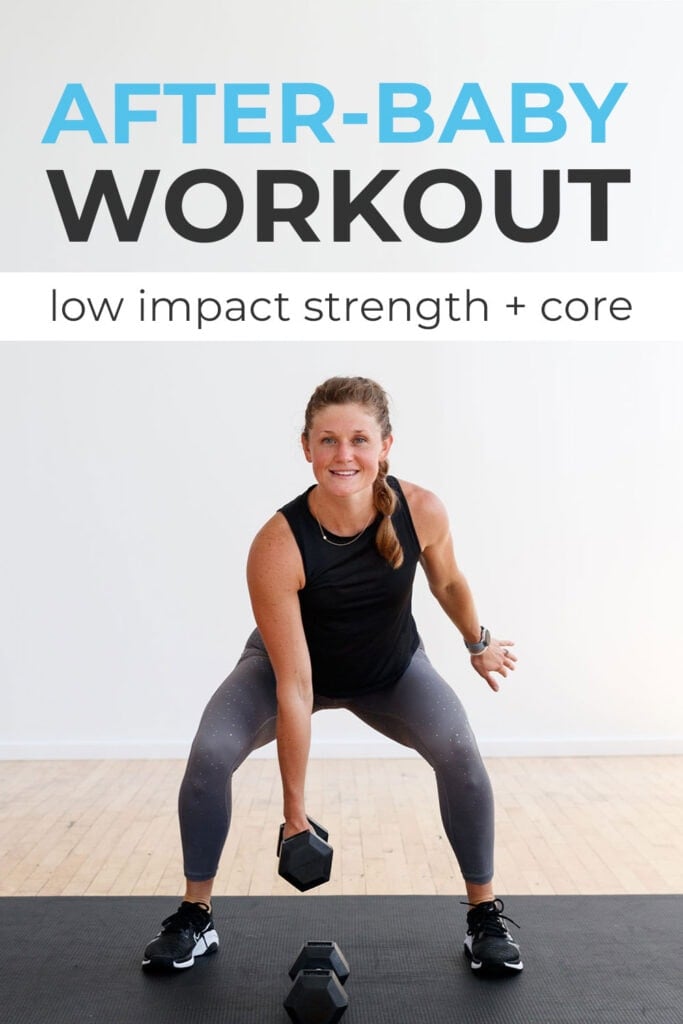
This post includes affiliate links. I do make a small commission for products purchased using these links (at no additional cost to you). Thank you for supporting Nourish Move Love, making the content you see on this blog possible.












